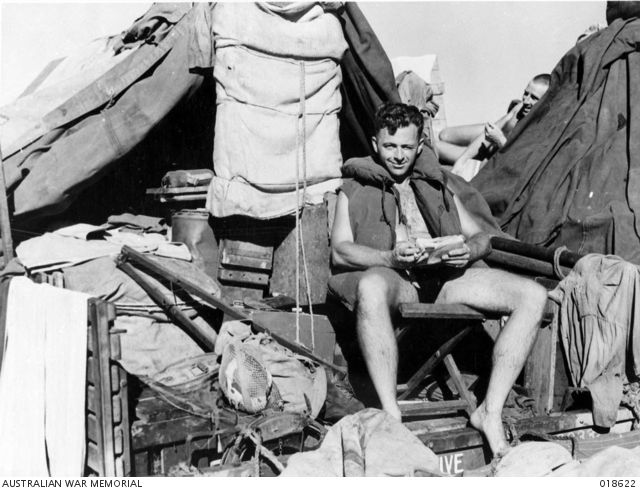
Private Thomas Costello was born on the 2 May 1917, and enlisted in the Australian Army on the 30 June 1941. The locality registered on his enlistment was Parramatta and his service number was NX37555. [1]
Thomas can be seen in this photograph in his ‘doover’ on board a Landing Ship, Tank (LST) on the way to Labuan Island, Brunei Bay, Borneo in 1945. [2] LST’s also known as tank landing ships were designed by the Allies during World War Two to support amphibious operations by carrying tanks, cargo and troops onto shores with no docks or piers. [3] A ‘doover’ is Australian military slang for just about anything. [4] Thomas is at sea on his way to Labuan Island, Brunei Bay, Borneo. In the final months of World War Two, Australian forces liberated Borneo from Japanese occupation in the only joint campaign of the war. The Royal Australian Navy (RAN), the Australian Army and the Royal Australian Air Force (RAAF) combined forces in this highly planned and significant campaign. [5]
On the 27 February 1946 Thomas was discharged from the Australian Army, and his posting at the time of discharge was the 2/13 Australian Composite Anti Aircraft Regiment. Prior to the advent of World War Two Australia had very little in terms of air defences, but as the war progressed anti-aircraft defences significantly developed. Many anti-aircraft batteries were involved with the threat from Japanese aircrafts, but as this threat subsided anti-aircraft defences were reduced. [6]
![]()
Caroline Finlay, Regional Studies Facilitator, Parramatta Heritage Centre, City of Parramatta, 2020
References:
[1] Australian Government Department of Veterans’ Affairs. (2020). DVA’s Nominal Rolls. Retrieved from https://nominal-rolls.dva.gov.au/veteran?id=155639&c=WW2
[2] Australian War Memorial. (2020). Driver Tom Costello of Parramatta, NSW. Retrieved from https://www.awm.gov.au/collection/C379592
[3] Wikipedia Contributors. (2020). Landing Ship, Tank. In Wikipedia, the free Encyclopaedia. Retrieved from https://en.wikipedia.org/wiki/Landing_Ship,_Tank
[4] Wikipedia Contributors. (2020).Digger slang. In Wikipedia, the free Encyclopaedia. Retrieved from https://en.wikipedia.org/wiki/Digger_slang
[5] Gilbert, G. (2016). The Australian experience of joint and combined operations: Borneo 1945. Australian Naval Institute. Retrieved from https://navalinstitute.com.au/5024-2/
[6] Wikipedia Contributors. (2020).Anti-aircraft defences of Australia during World War II. In Wikipedia, the free Encyclopaedia. Retrieved from https://en.wikipedia.org/wiki/Anti-aircraft_defences_of_Australia_during_World_War_II


